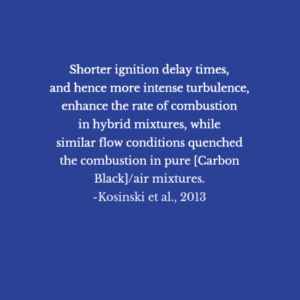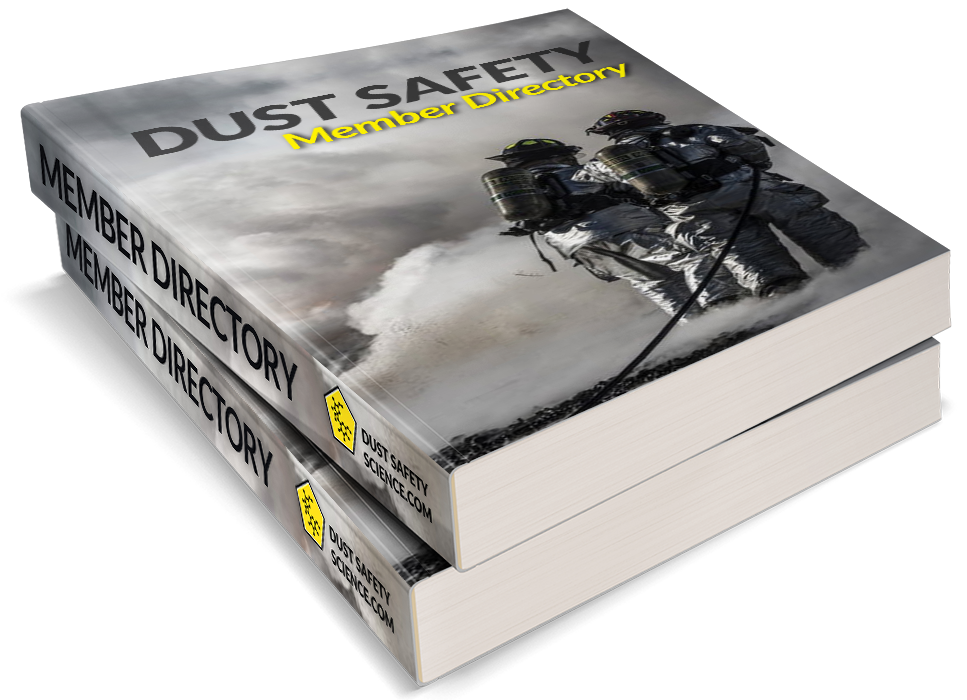1-Sentence-Sumary: Mixtures of nanometric carbon black dust and propane gas require the gas to be above its flammability limit to expload with 1kJ energy and demonstrate limited hybrid explosion enhancement above 3.0% by volume.
Authors: P. Kosinski, R. Nyheim, V. Asokan, and T. Skjold
Read in: Three Minutes
Favorite quote from the paper:

These authors perform explosion testing on mixtures of carbon black dust and propane gas in a USBM style 20-L chamber. The carbon black is a specialized material with very small particle diameter (average of 50 nm) and low volatile content. Explosion results are presented for dust concentrations ranging from 10 to 500 g/m3 and propane concentrations from 2.2 to 5.0% by volume.
The explosion experiments are performed with two ignition energies: a 6 J spark or 1 kJ chemical ignitor. Two ignition delay times of 60 ms and 120 ms are also tested to vary the turbulence level in the chamber.
Maximum pressure and maximum rate of pressure rise are analyzed for the dust, gas, and hybrid mixtures. The explosibility of the carbon black and hybrid mixtures is also explored. Lastly, scanning electron microscope imaging and thermo-gravimetric analysis of the post explosion particulate residue is performed.
Three of the main findings from this paper are:
- The carbon black dust alone was difficult to ignite under the experimental conditions with a 1 kJ chemical ignitor.
- The propane content had to be higher than its lower flammability limit (2-2.2%) in order for the hybrid mixture to expload
- Agglomeration of the carbon block particles played a significant role in dust and hybrid mixture explosibility.
The following sections outline the main findings in more detail. The interested reader is encouraged to view the complete article at the link provided below.
Finding #1: Nanometric carbon black dust is very difficult to ignite.
Using a 1 kJ chemical ignitor and a 60 ms delay time successful ignition was only achieved in one of four tests at 500 g/m3. When the ignition delay time was increased the dust was found to expload readily in the range from 250 to 500 g/m3. Even when an explosion occurred the maximum rates of pressure rise were less than 60 bar/s.
Finding #2: Hybrid mixtures of 50 nm carbon black required at least 2.2% propane gas to ignite
Unlike previous studies in the literature (e.g., Garcia-Agreda et al., 2011 and Sanchirico et al., 2011) the carbon black/propane was not found to expload at concentrations lower than the individual flammability limits of the fuels. The propane gas had to be increased above its flammability limit in order for the mixture to expload.
At gas concentrations near the flammability limit explosion violence was found to be larger than propane alone for low dust concentrations. At higher dust concentrations, heat loss to the dust decreased the rate of pressure rise substantially. For propane concentrations above 4.0% by volume the dust had a deceasing affect on rate of pressure rise. In all hybrid cases the lower ignition delay (higher turbulence level) had a larger rate of pressure rise.
Finding #3: SEM images showed a high degree of agglomeration of the carbon black particles
SEM images suggest that significant particle agglomeration occurs during the testing process. The agglomerate size after the explosion appears to be on the order of micrometers which is at least 50 times larger than the initial particle size. It is currently unclear if the agglomeration occurs during the dust dispersion or the dust reaction process.
My Personal Take-Aways From
“Explosions of Carbon Black and Propane Hybrid Mixtures”
This paper demonstrates that dust particles in the nanometer range may not behave in the same manner as larger particles. In this case it appears that hybrid effects seen in other papers do not occur. However, caution should be exercised as it is not currently clear if the effects that are seen here are from the experimental setup (e.g., dispersion process, agglomeration, ect…) and if these would be seen during a real industrial explosion scenario. Also note that at some concentrations the hybrid mixtures did expload more violently than the propane gas alone demonstrating the hazard of hybrid mixtures.
This article is useful for anyone involved with industrial processes that use carbon black dust. Furthermore, the data is useful for any processes using nanometric material and demonstrates a need to be cautious of 20-L testing with these materials. Other literature in this area may also be relevant including Eckhoff 2012, Turkevich et al., 2015, and Gao et al., 2016.
Full Citation: [bibtex file=references.bib key=Kosinski2013]
[otw_shortcode_button href=”http://www.sciencedirect.com/science/article/pii/S0950423012001374″ size=”medium” icon_position=”left” shape=”square”]> > Get The Article [/otw_shortcode_button]
